How to Win a Chess in Just 4 Moves? and How to Defend it?
The Scholar's Mate, also known as "Mate-in-Four," is a classic trick play for white players. It involves a specific sequence of moves that can checkmate your opponent quickly, if they don't know how to defend. This article will guide you through both sides of the Scholar's Mate: how to use it as white and how to stop it as black. So, whether you're a seasoned player or just starting out, this guide will help you master this famous chess maneuver.
Things you should know before: Here's how to pull it off:
- Open Strong: Begin by boldly moving your pawn two squares forward from e2 to e4.
- Bring in the Bishop: No matter your opponent's response, unleash your king's bishop diagonally to c4, aiming for the black kingside.
- Queen Takes Aim: If your opponent defends with their knight moving to c6, advance your queen to the powerful h5 square, putting pressure on the black king.
- Checkmate! Should your opponent move their knight again to f6, seize the opportunity! Capture the pawn on f7 with your queen, delivering a decisive checkmate and claiming victory.
Let's See in Detail Step wise:
Step 1:
Starting Strong as White: The e4 Pawn Push
As white, your opening move can set the tone for the entire game. A popular choice is to boldly advance your king's pawn two squares forward to e4. This move not only claims central control, but also opens up lines for your powerful bishop and queen.
Black's Response: A Crossroads
While black has various options for their first move, the most common response is to mirror your pawn push with e5. This creates a balanced position, but it also leaves them vulnerable to a surprise attack...
The Scholar's Mate Trap: A Potential Pitfall
Since e4 is a frequent opening move, your opponent might not anticipate your next steps. This is where Scholar's Mate comes in – a cunning four-move checkmate for white! However, it's important to remember that this tactic only works if you're playing with the white pieces.
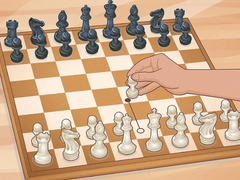
Step 2:
Unleash Your Bishop's Power!
The next step involves strategically positioning your king's bishop. Diagonally move it three squares from its starting position at f1 to c4. This maneuver:
- Targets a Vulnerable Pawn: Your bishop now puts pressure on your opponent's pawn at f7, opening up potential attacking opportunities.
- Initiates the Offensive: This move marks the beginning of your tactical plan, setting the stage for further assaults.
Black's Response: Countering the Threat
Anticipate your opponent's reaction. They might:
- Defend the Pawn: Move their knight from b8 to c6, protecting the pawn at e5.
- Challenge Your Position: Advance their king's bishop to c5, aiming to put pressure on your f2 pawn.
By understanding these possible responses, you can formulate your next move accordingly.
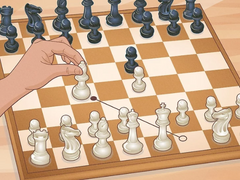
Step 3:
Bring in the Big Guns: The Queen's Gambit
Now it's time to unleash your most powerful piece: the queen. Move it diagonally across the board to the powerful square h5. This maneuver serves two purposes:
- Heightened Pressure: Your queen joins the bishop in targeting the vulnerable pawn at f7, tightening the grip on your opponent's position.
- A Potential Trap: If your opponent isn't aware of Scholar's Mate, they might instinctively move their knight to f7 to attack your queen. This, however, plays right into your hands for the final checkmate move.
Be Mindful of Your Opponent:
- The Unsuspecting Player: Against an inexperienced opponent, the knight move to f7 is a common reaction, setting the stage for checkmate.
- The Wary Opponent: Savvy players might suspect your plan and choose a more defensive move.
Alternative Move Order:
While the described sequence works well, you can also swap the moves of your queen and bishop. However, this might make your intentions of deploying Scholar's Mate more obvious to your opponent.

Step 4:
Strike Swiftly: Delivering Checkmate!
If your opponent has fallen prey to Scholar's Mate, this is your moment to strike! Move your queen decisively to f7, capturing the black pawn there. This brilliant move achieves two things:
- Instant Victory: You deliver a powerful checkmate to the black king. Their escape is impossible!
- Unbreakable Defense: Your queen is strategically positioned, protected by your bishop on c4. Any attempt to capture it would be futile.
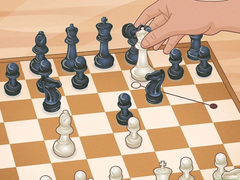
The Scholar's Mate in Action:
In chess notation, this remarkable four-move sequence is captured as:
- e4 e5 (Both pawns move forward)
- Bc4 Nc6 (Black defends their pawn)
- Qh5 Nf6 (Black falls for the trap)
-
Qxe7# (Checkmate!)
Note: It depends on who you are playing against. If you go for Scholar's Mate against someone who knows how to defend against it, you’ll only be putting yourself in a worse position. This is because when you play Scholar's Mate, you have to develop your queen straightaway, which leaves her open for attack.
How to Defend against Scholar's Mate
Step 1:
Shutting Down Scholar's Mate: A Strategic Defense
Facing a white opponent who opens with e4? Don't fall victim to Scholar's Mate! Here's how to shut it down early:
- Solid Start: Counter their e4 pawn push with a one-square move of your own king's pawn to e5. This disrupts the Scholar's Mate setup and blocks the path for their bishop.
- Building Defenses: For your next move, consider the "French Defense." Move your queen's pawn to d5, establishing a strong central presence.
- Fortifying Your Position: Follow up with your pawn to c5, further solidifying your control over the center and creating a defensive wall.
By following these steps, you can effectively neutralize the threat of Scholar's Mate and lay the groundwork for a solid opening position.
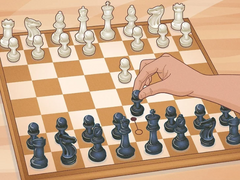
Step 2:
Strike First, Defend Well: Countering the Queen's Threat
Don't wait passively! Here's how to take control early and prevent your opponent's queen from dominating the board:
-
Early Knight Move: Instead of waiting, develop your knight and move it to f6 on the second turn. This achieves two things:
- Immediate Attack: You put pressure on their e4 pawn, potentially forcing them to react defensively.
- Blocking the Queen: By occupying f6, you make it harder for their queen to reach the powerful h5 square.
-
Possible Response: White might try to defend their e4 pawn by pushing a pawn to d3.
-
Your Counter-Move: Respond decisively by advancing your pawn to c6, followed by d5. This strengthens your central control and maintains pressure on their pieces.
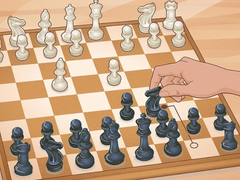
Step 3:
Squeeze the Queen: A Strategic Defense
Your opponent's queen is eyeing your position. Here's how to use your pawns to put pressure and force them to back down:
-
Pawn to the Rescue: Advance your pawn from g7 to g6. This maneuver achieves two goals:
- Direct Threat: It puts immediate pressure on their queen, limiting its movement.
- Blocking Maneuver: This pawn prevents the queen from reaching the powerful f7 square.
-
Opponent's Dilemma: White is unlikely to sacrifice their queen to capture your pawn.
-
Expected Response: They will probably retreat their queen back to f3, maintaining some pressure on your f7 pawn.
-
Your Follow-up: Now, solidify your defense by bringing out your knight to f6. This adds another layer of protection to your vulnerable pawn.
By using your pawns strategically, you can effectively neutralize the queen's threat and gain control of the situation.

Step 4:
Desperate Measures: The Queen's Risky Defense
If your opponent's queen is wreaking havoc, you might consider this risky counterattack:
-
Queen as Defender: As a last resort, move your queen diagonally to either e7 or f6.
-
Defense at e7: This position protects your e4 and f7 pawns, but restricts your bishop's movement.
-
Defense at f6: While offering protection to the same pawns, this square leaves your queen slightly more exposed to attack.
Important Note: Bringing out your queen early is dangerous, as it might get captured. If possible, it's recommended to choose a different opening strategy to avoid this situation altogether.

Scholar's Mate: Considerations for Offense (White)
- Quick Thinking: Scholar's Mate is a swift four-move checkmate, so act decisively and focus on making the correct moves quickly.
- Opponent's Awareness: Be mindful of your opponent's experience level. Scholar's Mate is less effective against seasoned players familiar with the tactic.
- Variations: Explore alternative move orders within Scholar's Mate to surprise your opponent and increase your chances of success.
- Sacrifices: In some variations, sacrificing a pawn early can create a mating net for your opponent's king. Evaluate if the potential checkmate outweighs the loss of material.
Scholar's Mate: Considerations for Defense (Black)
- Early Awareness: Recognizing the Scholar's Mate setup early is crucial for defense. Look out for the specific pawn moves and bishop development from white.
- Developing Pieces: Prioritize developing your knights and pawns, particularly the knight at b8, to challenge white's bishop and queen.
- Alternative Openings: Consider using different opening strategies like the French Defense or Sicilian Defense to avoid Scholar's Mate vulnerability.
- Calm Response: Don't fall into hasty moves like capturing the white pawn with your pawn, which can open the f7 square for a checkmate. Take your time and choose a safe defensive move.
Additional Considerations:
- Practice: Both offensive and defensive players can benefit from practicing Scholar's Mate against a computer or friend to improve their skills.
- Beyond Scholar's Mate: While Scholar's Mate is a fun tactic, it's important to focus on developing strong opening principles and understanding overall chess strategy for long-term improvement.













































Hinterlassen Sie einen Kommentar